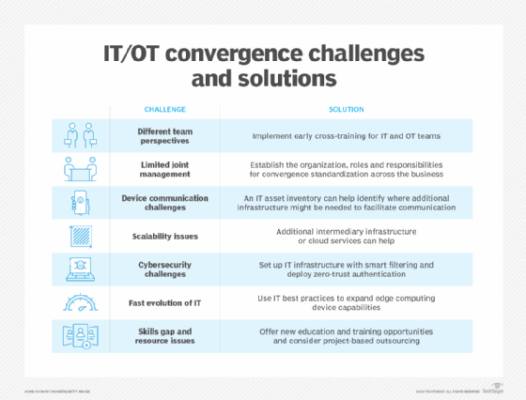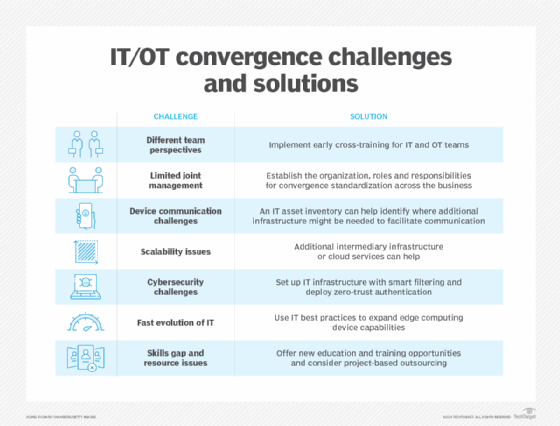
It’s been over a decade since Gartner accurately predicted the partnership between operational technology and information technology systems. The combination of the two disciplines and business areas is poised to revolutionize business operations beyond connectivity, drive automation, data analysis and cross-functional collaboration.
Although the partnerships might have started on the factory floor, the idea of aligning previously siloed systems to share and use business intelligence more efficiently has also spread to other industries. Healthcare and retailers have enjoyed the benefits of IT/OT convergence as they streamline their workflows, improve productivity and increase their bottom lines.
The explosion of AI tools and AI-supported workflows has made this collaboration even more essential for organizations looking to increase quality and productivity. Yet, they might still hesitate to implement IT/OT convergence as stakeholders have such different approaches to security, data management, system availability and architectures. Some organizations might still need to overcome these differences. Those open to it will enjoy the benefits of merged business processes, insights and controls into a uniform environment. The positive effects the overall business and organization will see are key to bringing the previously siloed IT and OT groups together.
Why IT/OT convergence matters
“It’s becoming table stakes to compete in any market,” Jonathan Lang, research manager of worldwide IT/OT strategies at IDC, told IoT Agenda. Not only are industrial and manufacturing companies enjoying the benefits of this convergence, but the rest of the business world is starting to notice. Internet of things (IoT) devices are becoming smarter and smaller. They’re easier to manage today, making them a viable option for a wider range of organizations, businesses, industries, and even cities and municipalities.
Any organization looking to deploy IoT devices while gaining new efficiency levels, building more responsive customer relationships and developing new business models must combine their business IT and OT areas. IT/OT convergence is a necessary step to achieving a tech-based future.
Benefits to IT/OT convergence
The general benefits of IT/OT convergence are cost, performance and productivity gains. It leads to optimizations and transformations across the organization, from operations to business.
1. Lower operational costs
Convergence helps organizations lower operating costs by optimizing resource utilization, energy, cooling and device management. There are fewer systems to procure and maintain when sharing infrastructure, and legacy infrastructure is replaced by more efficient systems. It can also lead to data center and real estate savings, as single-function devices can be consolidated into integrated systems and free up valuable space.
2. Better performance
Combining IT and OT data means organizations can generate more accurate and meaningful KPIs. KPIs help drive efficiency and higher performance across the organization, helping both teams pursue and achieve common goals. Convergence increases visibility into both areas companywide, giving the rest of the organization a view into how technology helps achieve common objectives.
Businesses will likely seek to derive more value from their data by increasing the use of edge AI analytics. Instead of transferring data into larger pools or data warehouses for future use, they can analyze and use data close to where it was gathered. Edge AI analytics reduces the reliance on cloud data storage, eliminates latency issues and enables real-time decision-making. That’s why manufacturing, healthcare and transportation companies are increasingly recognizing the advantages of edge AI for machine learning, according to a Wevolver report.
3. Improved flexibility
Access to real-time data and KPIs empowers organizations to react more quickly to market changes. They can efficiently change production timelines based on outside factors, while still meeting business objectives. Convergence optimizes workflows and eliminates redundant ones, enabling the organization to operate more efficiently.
Convergence projects often include digital twins, where a virtual model of a physical object or workflow is created. The twin can be set up to use the same real-time data as the actual object when running simulations to identify performance issues and generate improvements without affecting the production environment. Companies can use the twins to identify areas for improvement and test the upgrades before rolling them out immediately to production facilities. Optimization, maintenance predictions, changeovers and production line changes can all be handled faster and more efficiently because of the “practice” done with the digital twin.
4. Enhanced training
Smart technology, such as augmented reality and smart glasses, can enhance training opportunities across operations by providing workers with real-time information and hands-free visual guidance. For example, new employees can be walked through processes on-site by an expert based elsewhere in the organization. This could reduce or even eliminate the $413 billion employers in the U.S. spend on informal on-the-job training.
5. Increased operational standards
Some organizations use the IT/OT convergence project to bring longstanding IT best practices to their operational systems. For example, incorporating a patch management program into OT devices ensures they’re operating with the latest firmware. Existing IT monitoring technologies can be extended to OT systems and devices, enabling real-time monitoring and centralized asset tracking. Multiple functions can be consolidated into one monitoring system or console for faster user experiences to streamline predictive maintenance tasks.
6. Enhanced security orchestration
Converged IT/OT systems can bridge the gap between cybersecurity and physical security for organizations with centralized monitoring systems and tools. That’s because IT and OT systems have different security needs and capabilities that usually can’t be met with one strategy or tool. IT/OT convergence projects increase OT security visibility across the organization and help IT teams incorporate existing systems into an overall cybersecurity strategy.
The challenges to successful IT/OT convergence
Now that we’ve seen the benefits of IT/OT convergence projects, it’s time to look at the challenges and learn how to overcome them.
1. Different team perspectives
IT and OT teams have different perspectives, responsibilities and areas of concern, so getting them to work together on a convergence project can be challenging. “There are two groups, two sets of technology and two groups of concerns,” Sid Snitkin, vice president of cybersecurity services at the Arc Advisory Group, told IoT Agenda.
IT teams are used to dealing with business data and executives and using the latest technology and practices. On the other hand, OT work is all about manufacturing and using systems or physical devices designed to last for decades.
IT teams are also used to planning for regular upgrades, patches and other maintenance activities. OT teams regularly extend the use of their tech to ensure they’re not risking control processes and production yields, which can have significant and unintended consequences.
Solution: Early cross-training for IT and OT teams can help create the collaborative environment needed to give visibility to each other and create trust between them. They can better understand the value each perspective brings and how they must work together to maintain it.

2. Limited joint management
Most companies don’t have joint management or governance of IT/OT convergence initiatives, cross-technology strategies or company policies. This usually leads to high levels of duplicate and overlapping processes and conflicting policies. Add to this the lack of interdisciplinary skills, expertise and mismatched tech architectures between IT and OT environments, and there are significant challenges on both sides.
Solution: Establish the organization, roles and responsibilities for convergence standardization across the business. That means looking at processes, KPIs, skills, data, security guidelines, tech stacks and licensing agreements. This ensures that standards are applied consistently, scaled and maintained effectively, and it reduces confusion and conflict across the organization.
3. Device communication challenges
Many edge devices are only capable of one-way communication or have little computing power. For example, an industrial sensor may generate a stream of outbound data but cannot accept inbound traffic. Others may not use standard communication protocols and are, therefore, incompatible with existing IT networks. In these cases, IT/OT convergence requires extra work by both teams.
Solution: An IT asset inventory can help identify where additional infrastructure might be needed to facilitate communication from the OT devices, indicate which devices must be replaced with more modern equipment and ensure that everyone knows where gaps exist.
4. Scalability issues
Today’s edge devices produce massive amounts of data. Unless the IT systems are prepared, the devices may overwhelm the infrastructure. IT teams may not have a complete picture of the number of edge devices in the fleet because of OT asset monitoring limitations and may be unprepared for the actual number.
Solution: Additional intermediary infrastructure or cloud services can help manage the data flow from OT devices to the IT network. A documented convergence strategy that includes a scalability section with current and future states can also guide the convergence team to ensure all use cases are covered. Mirroring assets and workflows with digital twins can help identify potential failure points without affecting the production environment.
5. Cybersecurity challenges
Protecting an integrated IT/OT network is a significant challenge, especially when using older OT devices. These devices were often manufactured with minimal consideration for security, making them an ideal target for criminals to launch an attack against the entire network. A single cybersecurity posture may not be enough to cover all the devices in a fleet. Many of the currently available tools aren’t ready for the complexity of IT/OT convergence in terms of size, location, data type and tech stacks — especially those with legacy systems that might be more vulnerable to cyberattacks.
Solution 1: IT and OT security standards are often separate and can remain that way. However, they should share a single operating model to ensure that all controls are consistently applied to both systems and environments. This includes guidelines and standards for asset management, connectivity, data bandwidth, data transmission and communication, data loss prevention, security operations, and incident response and recovery.
Solution 2: Because OT devices tend to produce data packets with specific structures that don’t change, IT infrastructure can be set up with smart filtering to detect and eliminate anomalous packets that may indicate an attack. Zero-trust authentication can also be deployed on the devices to protect their communications.
6. The speed of IT’s evolution
Innovation has driven IT to move to more as-a-service models and cloud services in the last decade. OT hasn’t had the same opportunities for innovation because of its focus on mostly closed and operations-centric workflows and requirements. Edge devices tend to be less complex and powerful, so they can’t meet the demands of more advanced IT systems.
Solution: Edge computing devices can use IT best practices to expand their capabilities into newer use cases. For example, by using cloud data aggregation services, organizations can gather and analyze data produced by older OT devices to simulate the real-time advanced analytics that happens on newer devices.
7. Skill gaps and resource issues
Even with technology’s evolution and the swift rise of AI tools, the right tech talent is hard to find. In particular, high-skill technical roles, such as system architects and cybersecurity specialists, and proficiency in specific technical skills, such as automation, cloud security and IoT infrastructure, are becoming like “unicorns,” one tech leader told Deloitte Insights.
Solution: Short-term solutions, such as project-based outsourcing, can help move an initiative or project forward. Offering new education and training opportunities in newer technologies to current employees can be a cost-effective, long-term solution to developing the needed skills. HR teams should consider expanding the talent pool and speaking to people with the right skills from different backgrounds. Developing new approaches to mentorship, training and career guidance is another way to attract new employees and build a better talent pipeline, especially for younger people who might not have had a chance to do so over the last few years.
IT/OT convergence offers many benefits to organizations across all areas and teams. It can modernize any OT deployment, align it with current IT best practices and help organizations realize significant long-term benefits. These include improved productivity and performance, greater transparency into workflows across production and operations, reduced production costs and increased revenues.
Julia Borgini is a freelance technical copywriter and content marketing strategist who helps B2B technology companies publish valuable content.


